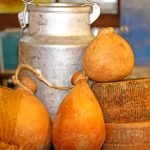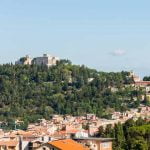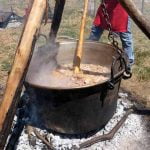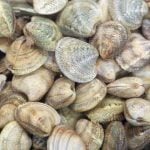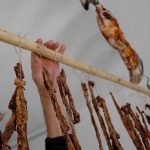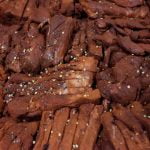The foundation of much of Campobasso's cuisine consists of common, organic ingredients that are readily available in and around the city. However, unlike other cities in Italy, the dishes traditionally found in the Campobasso region are not included on menus throughout the country. This Southern Italian city must be visited to truly experience the local fare.
Located in the southeastern province of Campobasso in the region of Molise, the city of Campobasso has a diverse terrain. It is situated in the Biferno River basin between the Matese and Sannio mountain ranges. The varied landscape lends itself to the cultivation of potatoes, grapes, olives, zucchini, and wheat. Different varieties of legumes can be found in the region including chickpeas, fava beans, lentils, and other varieties of beans - all of which can be found in local recipes including many popular soups.
The surrounding woodlands provide the perfect landscape for growing another local favorite - mushrooms - such as gallinaccio and porcini, as well as truffles. The Molise region is considered to be among the leading producers of truffles in the country with the white and scorzone varieties being among the most well-known. They can be found as a topping for pasta or incorporated in cheese - such as the scamorza ripiena di scorzone - a roasted, lightly breaded cheese curd rind flavored with truffle. The dark scorzone truffle has a hazelnut-colored pulp and is highly desirable in numerous dessert recipes.
Much of the area's animals are raised to be sold - therefore meat is less prominent in local gastronomy compared to other parts of Italy. Meats that are traditionally found in the city’s cuisine include - sausages, prosciutto, salame, capicola, pork rinds, pork belly, and torcinelli (or lamb offal).
WHAT ARE THE TRADITIONAL APPETIZERS IN CAMPOBASSO
A meal in Campobasso traditionally begins with an assortment of cured meats and local cheeses. A common staple on local menus is Formaggio di Petracatella - a cheese produced right in Campobasso from a mixture of goat, sheep, and cow milks. Once aged in the traditional tufa caves in the area, the interior becomes soft and yellow with a slight dampness while the exterior rind is yellow and crinkled. To enjoy it like a local, it can be eaten all on its own or alongside slices of cured meats or pickled vegetables.
WHAT IS SERVED AS A FIRST COURSE IN CAMPOBASSO
After enjoying a light appetizer, the first course in Campobasso cuisine is similar to much of Italy in that the dishes often feature pasta. While other parts of the country have adopted cavatelli, visitors should give it a try where it originated - in the Molise region. Meaning "little hollows", cavatelli is a pasta made from water and flour (and sometimes potatoes are added to the dough). They are rolled by hand with a hollow space on one side - perfect for catching the flavors of any sauce or seasoning added to the top. In Campobasso, cavatelli are often served with a sauce made from pork meat, specifically pork ribs or ciccioli, which are pressed pieces of fatty pork.
Taccozze e fagioli is another dish that visitors may find on this portion of the menu. The dish consists of handmade pasta that has a rhombus shape. The pasta is usually served with beans, pork rind, and a drizzle of extra virgin olive oil.
Soup is also a popular choice due to the availability of locally grown vegetables and legumes. Pearl barley, beans, lentils, and potatoes are often combined with herbs and spices to make a delicious soup.
One local variation of soup is known as pizza e minestra, also known as pizza e foje. A staple peasant dish, pizza e minestra typically consists of a vegetable soup that may be flavored with pork paired with a cornmeal-based flatbread soaked in the cooking liquid of local vegetables.
WHAT TYPE OF SECOND COURSES ARE TRADITIONALLY OFFERED IN CAMPOBASSO
Moving into the second course of the meal, visitors can expect to see some type of meat on their plate.
Sheep have played a large role in the socio-economic aspect of Campobasso for many years. The climate and surrounding terrain provide an ideal location for sheep farming to prosper. As a result, mutton is found to be the meat source in numerous dishes served locally. Pezzata is made up of boiled mutton, vegetables, potatoes, and herbs. Typically, it is all slow cooked in a copper pot so the meat is tenderized and the flavors have time to strengthen.
Other popular second course dishes include torcinelli - a combination of any "leftover" lamb parts, such as the intestines and liver, stuffed inside the sheep's gut and grilled or made into hearty stew and baccalà arracanato - cod fish covered in breadcrumbs, raisins, walnuts, pine nuts, olives and cherry tomatoes. The fish is traditionally pan cooked in a fireplace, covered in ashes.
A dish like caponata encompasses local gastronomy by utilizing many ingredients found right in Campobasso. It is made of wheat crackers called taralli that are moistened with vinegar and water and accented with flavor from peppers, tomatoes, black olives, boiled eggs, and anchovies.
WHAT ARE THE TRADITIONAL SIDE DISHES & CONDIMENTS IN CAMPOBASSO, ITALY?
To accompany a meal in Campobasso, there are side dishes and condiments preferred by the locals. On the side it is common to see locally grown vegetables that are in season. Visitors may also find a small bowl of soup served to compliment a main dish such as sagne e fagioli - a noodle and bean-based soup with a light sauce prepared from oil, garlic, tomatoes, and chili peppers.
With a wide variety to choose from, cheese is frequently used as a condiment - shredded, grated, thinly sliced. From mild to sharp and everything in between, there is a cheese to compliment many dishes including - scamorza, caciocavallo, pecorino, and burrino.
WHAT KIND OF STREET FOOD CAN BE FOUND IN CAMPOBASSO ?
The variety of street food throughout Italy changes from region to region and city to city. Each area has its own take on grab-and-go food options. In many areas - including Campobasso - these easy to eat items are often sold from food carts and other small pop-up vendors in areas of heavy pedestrian traffic. In Campobasso, a popular choice is pampanella. It is made with pork, chili peppers, vinegar, salt, and garlic - served fresh out of the oven on a bun.
WHAT ARE THE BEST DESSERT OPTIONS IN CAMPOBASSO
A meal in Campobasso would not be complete without a decadent dessert. Visitors must try cauciuni - a dish made with legumes, which is not uncommon in Southern Italian regions. This ravioli like exterior is filled with cocoa, chickpeas, spices, such as cinnamon and cloves, candied fruit, and liqueur - then fried and served with a topping of honey and sugar.
Other desserts that can be found on local menus include savoiardi - a sweet biscuit that is often dipped in chocolate or pudding - and screppelle - doughy fritters made from potatoes. The latter is a traditional favorite for Christmas and other special holidays.
WHAT WINES COME FROM CAMPOBASSO, ITALY?
While not one of Italy's prominent wine regions, Campobasso and its Molise region have the terrain suitable for cultivating grapes for their own local wines. Wine production in this valley area dates back to 500 BC. Once produced for the sole purpose of local consumption, vintners are growing to keep up with the steady increase in tourism. Visitors can find delicious reds, whites, and rosés.
Molise currently produces three wines designated as DOC, or Denomination of Controlled Origin. This designation ensures the wine is produced in a particular location and follows specific quality standards. The Biferna wines are produced within the Campobasso province and are offered in two red varieties and a rosé wine. They stand out from the other local wines with their more dominant body and lower acidity.
Visitors may also experience the other two Molise DOC wines - the Molise and Pentro di Isernia. The Molise is available in a more extensive variety of reds such as Cabernet Sauvignon and Sagniovese and whites including the Chardonnay and Moscato. Pentro di Isernia DOC is offered in a Bianco (white), Rosso (red), and Rosato (rosé).
Campobasso is a gateway to lesser-known regional cuisine of Southern Italy. Travelers to Campobasso can savor Molise’s specialties including cavatelli pasta, legume-based soups, handmade cheeses, and flavorful local wines.
Travel Guides
[wudrelated include="1837"]
The Molise Region of Italy
[wudrelated include="4241"]
The Cities of Molise, Italy
[wudrelated include="4242"]
